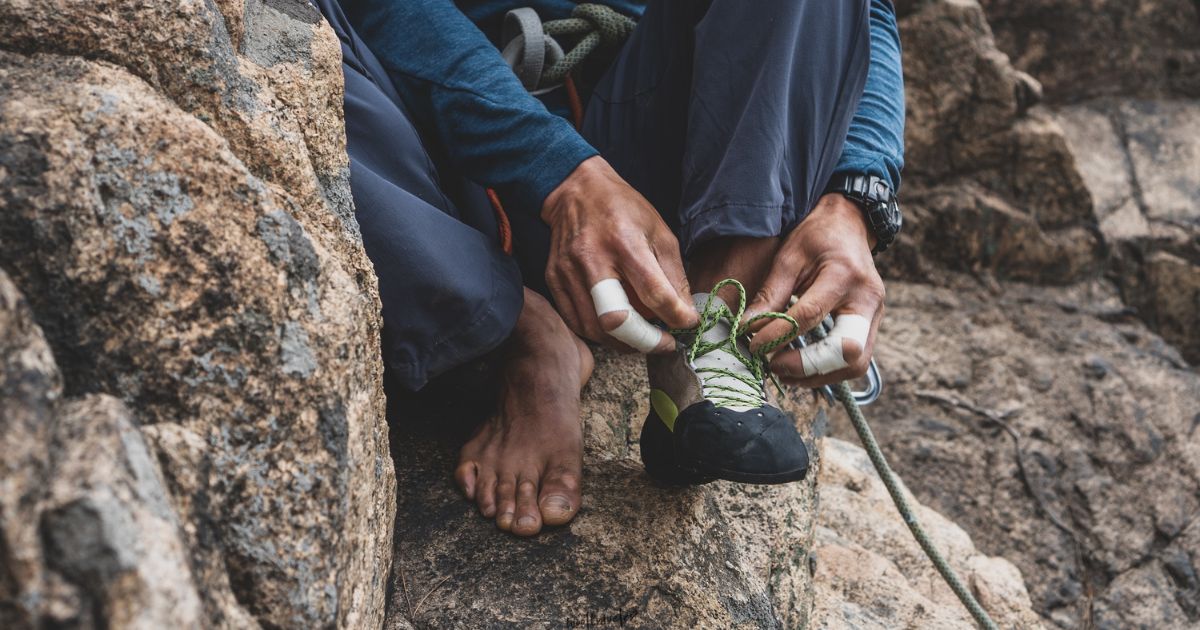Table of Contents
How to Break In Climbing Shoes: The Complete Guide
Learning how to break in your shoes is crucial for getting the most out of your climbing experience, regardless of your experience level. Keep reading as we explore “How to Break in Climbing Shoes” to maximize the performance of your climbing shoes.
We’ll reveal the mysteries of the fire, ice, and water techniques in this extensive guide, delving into the subtleties of each to assist you in finding the ideal fit.
Knowing How to Fit Climbing Shoes
Unlike your average sneakers, climbing shoes require a specific fit to function at their best. A tight fit is necessary for the precision required in climbing footwork, and this is frequently correlated with improved performance. Selecting a performance fit entails accepting the possibility of discomfort throughout the break-in phase.
Breaking Down the Complexity
The essential tool in a climber’s toolbox, climbing shoes are not at all like your average sneakers in terms of comfort. Their special design is made with accuracy in mind, which is essential for learning the complex footwork required on climbing surfaces. Climbing shoes are not like casual sneakers in that they need a specific fit to reach their maximum potential.
The Precision Paradox
Climbing is all about the precision of every move, and it all begins at the bottom. Shoes designed for climbing are made to fit tightly around the foot, creating a close bond between the climber and the rock. The ability of a climber to perform maneuvers with accuracy and control is directly impacted by this precise fit, making it a necessity rather than just a luxury.
Correlation with Performance
A key principle of climbing is the relationship between increased performance and a snug fit. The more tightly the shoes fit, the more sensitive they get to the climber’s movements. The relationship is symbiotic, with the climber’s movements being smoothly transmitted from the shoe to the climbing surface. But there are obstacles in the way of achieving this symbiosis, especially during the infamous break-in period.
The Performance Fit Dilemma
Climbers consciously choose a performance fit to improve their climbing experience. The possible discomfort during the break-in period is the trade-off associated with this decision, though. In contrast to the accommodating padding of casual sneakers, climbing shoes require the climber to possess resilience. The first tightness, which is frequently on the verge of discomfort, is the key to realizing the full potential of the shoe.
Tightness and Targeted Footwork
The rationale for the discomfort stems from the requirement for a snug fit. The tightness has two functions: it helps with accurate foot placement and reduces play inside the shoe to ensure direct power transfer. Toe hooking and edging are examples of advanced techniques that climbers strive for, and the snug fit of a performance-fit climbing shoe provides comfort.
Managing the Time of the Break-In
Climbers who are dedicated to reaching their peak performance consider the break-in period as a necessary transition. On this journey, the climber’s discomfort gives way to familiarity, and the shoe adapts to the unique characteristics of the foot. The benefits of an optimized, performance-driven fit outweigh the short-term discomfort, despite the potentially painful process.
Unveiling the Ice Method
Step 1: Preparing the Shoes
The ice method needs to be carefully prepared before beginning. Slide open your climbing shoes and insert a plastic bag. Make sure there is a pocket of air in the bag before adding water, and knot it firmly.
Step 2: Freezing Process
The key to using the ice method is the freezing process. To allow the water to freeze and expand naturally, place the prepared shoe in the freezer for an entire night. Get the shoes the next day, and break the ice gently if needed.
Step 3: Breaking In
The exciting part is about to begin: breaking in your climbing shoes. To hasten the breaking-in process, strap them firmly, move around, and make foot movements.
The Water Method
Step 1: Shoe Preparation
Soak your climbing shoes in water for about five minutes, using a bucket or the shower. This method encourages flexibility without sacrificing structure, which makes it especially helpful for shoes with synthetic, unlined uppers.
Step 2: Post-Immersion Care
It’s time for post-immersion care once your shoes have soaked in their cool water bath. To speed up the breaking-in process, move your feet, walk, and dance. After that, stuff the shoes with paper and place them somewhere warm and dry.
The Fire Method
Step 1: Oven Preheating
Set the oven temperature to approximately 120 degrees Celsius to begin the fire method. Climbers who want a rapid break-in period without sacrificing the shoe’s overall structure should use this method.
Step 2: Warming the Shoes
Your climbing shoes should only be in the oven for three to five minutes, so handle them carefully. Take care that they don’t get too hot. Put them on once they’re heated, and keep them on until they cool down. To keep the shoes in the desired shape while they cool, stuff them with newspaper.
Evaluating the Results: Finding Your Perfect Fit
It is essential to evaluate the outcomes following each method’s experimentation. The Ice Method provides a noticeable expansion, even with its 24-hour commitment. The Water Method molds the shoe for a comfortable fit, even though it’s not the fastest. The Fire Method softens the shoe, but it’s not as transformative as it could be.
Insights and Recommendations
The Ice Method: A Slow Freeze for a Perfect Fit
The ice method is notable for its capacity to yield a discernible expansion, despite its time-consuming nature. Climbers who value a slow break-in period will find this method especially helpful, as it allows the shoe to naturally conform to the foot.
The Water Method: Immersion for Flexibility
The water method is a great option for people who want to balance comfort and time efficiency. Climbers who want both comfort and performance can consider the shoe because of its enhanced flexibility without sacrificing its structural integrity due to its immersion experience.
The Fire Method: Quick and Effective Softening
The fire method is a quick fix if time is of the essence. This method softens the shoe effectively and speeds up the break-in period, despite being less transformative. Time-pressed climbers might find this approach especially interesting.
Final Thoughts
In summary, breaking in climbing shoes is an art form, with each technique adding its own distinct brushstrokes to the composition. Finding the ideal fit without sacrificing performance is the aim, regardless of your preference for a rapid warm-up, slow freeze, or deep soak. Try out these techniques to find the one that best suits your climbing technique.
Related Posts
- Foot placement for climbing beginners
- Training Drills Every Climber Should Do
- The 7 Essential Movements of Bouldering
- The 5 Fundamentals of Climbing You Need to Know
- How to Flag: A Climbing Technique for Developing Balance
- How To Improve Your Climbing Footwork? – 4 key Stages
- 8 Essential Tips for Outdoor Rock Climbing Beginners
- 7 Techniques Every Climber Must Know
- The 7 Best Climbing Shoes for Beginners
- 5 Best Bouldering Shoes
- Moderate Rock Climbing Shoes – Your Ultimate Guide
- Aggressive Climbing Shoes: A Quick Guide for Every Climber










Discussion about this post